|

Πλάτος ράχης
Για να υπολογίσετε το πλάτος της ράχης
για χαρτί χωρίς επικάλυψη 80 g/m2 - ο αριθμός των σελίδων πρέπει να πολλαπλασιαστεί επί 0,05 mm (στρογγυλοποίηση έως 1 mm),
για χαρτί χωρίς επικάλυψη 90 g/m2 - ο αριθμός των σελίδων πρέπει να πολλαπλασιαστεί επί 0,055mm (στρογγυλοποίηση έως 1mm),
για χαρτί χωρίς επικάλυψη 70 g/m2 - ο αριθμός των σελίδων πρέπει να πολλαπλασιαστεί επί 0,045mm (στρογγυλοποίηση έως 1 mm),
για χαρτί χωρίς επικάλυψη 120 g/m2 - ο αριθμός των σελίδων πρέπει να πολλαπλασιαστεί επί 0,074 mm (στρογγυλοποίηση έως 1 mm),
για χαρτί χωρίς επικάλυψη 150 g/m2 - ο αριθμός των σελίδων πρέπει να πολλαπλασιαστεί επί 0,0925 mm (στρογγυλοποίηση έως 1 mm),
για το χαρτί Ecco-Book Cream and White vol. 2.0, 70 g/m2 - ο αριθμός των σελίδων πρέπει να πολλαπλασιαστεί επί 0,0685 mm (στρογγυλοποίηση έως 1 mm),
για το χαρτί Ecco-Book Lux vol. 1.8, 90 g/m2 - ο αριθμός των σελίδων πρέπει να πολλαπλασιαστεί επί 0,078 mm (στρογγυλοποίηση έως 1 mm),
για το χαρτί Munken Print White and Cream vol. 1,5 90 g/m2 - ο αριθμός των σελίδων πρέπει να πολλαπλασιαστεί επί 0,0675 mm (στρογγυλοποίηση έως 1 mm),
για χαρτί Munken Print White and Cream vol. 1.5 150 g/m2 - ο αριθμός των σελίδων πρέπει να πολλαπλασιαστεί επί 0,1125 mm (στρογγυλοποίηση έως 1 mm),
για χαρτί με επικάλυψη ματ και γυαλιστερό 115 g/m2 - ο αριθμός των σελίδων πρέπει να πολλαπλασιαστεί επί 0,045 mm (στρογγυλοποίηση έως 1 mm),
για χαρτί με επικάλυψη γυαλιστερό 150 g/m2 - ο αριθμός των σελίδων πρέπει να πολλαπλασιαστεί επί 0,052 mm (στρογγυλοποίηση έως 1 mm),
για χαρτί με επικάλυψη ματ 150 g/m2 - ο αριθμός των σελίδων πρέπει να πολλαπλασιαστεί επί 0,06 mm (στρογγυλοποίηση έως 1 mm),
για χαρτί με επικάλυψη ματ και γυαλιστερό 200 g/m2 - ο αριθμός των σελίδων πρέπει να πολλαπλασιαστεί επί 0,084 mm (στρογγυλοποίηση έως 1 mm),
Χαρτί Inkjet:
Για να υπολογίσετε το πλάτος της ράχης
για χαρτί JetStar χωρίς επικάλυψη 80 g/m2 - ο αριθμός των σελίδων πρέπει να πολλαπλασιαστεί επί 0,05 mm (στρογγυλοποίηση έως 1 mm),
για χαρτί Alto vol. 1,5 90 g/m2 - ο αριθμός των σελίδων πρέπει να πολλαπλασιαστεί επί 0,0675 mm (στρογγυλοποίηση έως 1 mm),
για χαρτί Bio Top 3 vol. 1,35 90 g/m2 - ο αριθμός των σελίδων πρέπει να πολλαπλασιάζεται επί 0,06075 mm (στρογγυλοποίηση έως 1 mm),
για το χαρτί Munken Print Cream vol. 1,5 90 g/m2 - ο αριθμός των σελίδων πρέπει να πολλαπλασιαστεί επί 0,0675 mm (στρογγυλοποίηση έως 1 mm),
Παράδειγμα: πλάτος ράχης = 250 x 0,05 mm = 12,5 mm ~ 13 mm
Προετοιμασία εξωφύλλου για μέγεθος Α4 (210mm x 297mm)
οριζόντιο μήκος: 210mm x 2 + ράχη + 6mm περικοπή = 426mm + ράχη,
κατακόρυφο μήκος: 297mm + 6mm περικοπή = 303mm
Προετοιμασία εξωφύλλου για μέγεθος Α5 (148mm x 210mm)
οριζόντιο μήκος: 148mm x 2 + ράχη + 6mm περικοπή = 302mm + ράχη,
κάθετο μήκος: 210mm + 6mm περικοπή = 216mm
Προετοιμασία του εξωφύλλου για το μέγεθος B5 (170mm x 240mm)
οριζόντιο μήκος: 170mm x 2 + ράχη + 6mm περικοπή = 346mm + ράχη,
κάθετο μήκος: 240mm + 6mm περικοπή = 246mm
Δεν απαιτείται περικοπή για ασπρόμαυρες σελίδες.
Απαιτούνται περιθώρια 7 mm.

Σημείωση: Μην τοποθετείτε κείμενο σε βιβλία με ράχη λεπτότερη από 6 mm.
Γραμμές
Το ελάχιστο πάχος γραμμής είναι 0,25p (0,088 mm)
Γραμματοσειρές
Το ελάχιστο μέγεθος γραμματοσειράς είναι 4p
Όλες οι γραμματοσειρές στο κείμενο πρέπει να μετατραπούν σε καμπύλες ή να ενσωματωθούν στο αρχείο pdf.
Φόντο
Η ελάχιστη χρήση χρώματος είναι 5% οποιουδήποτε συστατικού (π.χ.: C-0 M-0 Y-0 K-5)
Πλήρης µαύρο χρώµα επιτυγχάνεται µε τη χρήση µόνο του µαύρου συστατικού (C-0 M-0 Y-0 K-100), δεν χρειάζεται να χρησιµοποιηθούν άλλα συστατικά.
Χρώμα - μόνο CMYK σε κάθε γραφικό έργο. Εάν θέλετε να χρησιμοποιήσετε χρώματα (Pantone, HKS, κ.λπ.) θα πρέπει να αναζητήσετε κατάλληλη απεικόνιση CMYK.
Διαβαθμίσεις
Οι διαβαθμίσεις δεν πρέπει να είναι μικρότερες από το 5% της τονικής μετάβασης.
Ψήφισμα
Οι εικόνες και τα γραφικά πρέπει να έχουν ανάλυση 300DPI και χρωματικό πλαίσιο CMYK (SWOP Coated CMYK).
Αρχεία
Η προτιμώμενη μορφή αρχείου είναι PDF. Άλλες μορφές αρχείων είναι αποδεκτές, αλλά θα χρεώσουμε επιπλέον χρέωση για τη μετατροπή.
Αποδεκτές μορφές αρχείων:
CDR CorelDraw ver. 11, γραμματοσειρές που έχουν μετατραπεί σε καμπύλες, CMYK
JPG ανάλυση 300 DPI, μέγιστη ποιότητα, CMYK
All files should be added with no layers or transparencies (flattened)
Book Edge Printing (CMYK)This technique involves applying pigment inks to the edges of the book block paper. It is done in CMYK. The process enables printing themes, captions and graphics that can function as an extension of the cover illustration or supplement it. We also provide edge printing on books with rounded block corners.
Technical information:
- the ink may flow slightly between the sheets during printing,
- maximum book format: 210 x 297 mm (A4),
- maximum print width: 290 mm,
- minimum block thickness: from 1 mm,
- Pantone or other special colours will be converted to CMYK,
- the colours used on the book's edges should be similar to avoid soiling.
File preparation:
- IMPORTANT: edge's graphic designs should be prepared in vertical format,
- files must be in .pdf format (we recommend PDF/X-4:2010),
- graphic design format must include bleeds of 3 mm on each side,
- acceptable design resolution: 300 DPI,
- a separate file is required for each edge of the block to be printed (X1, X2, X3),
- files should be named as follows: X1_name_top.pdf, X2_name_front.pdf, X3_name_bottom.pdf,
- please attach a preview file with the positioning of the graphics according to the following example for your order:
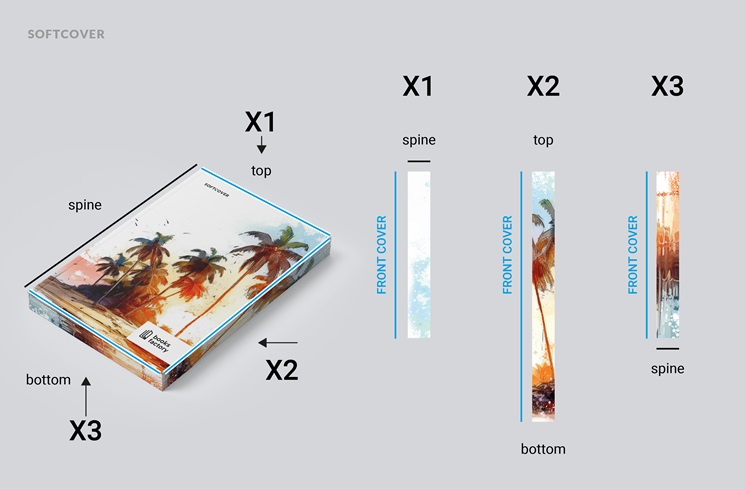
for several books (e.g. a trilogy) with split graphics, please prepare a shared file for each edge of the block.
Each file should contain the whole print design for that part of the graphic so that the books when standing side by side, form a coherent whole.
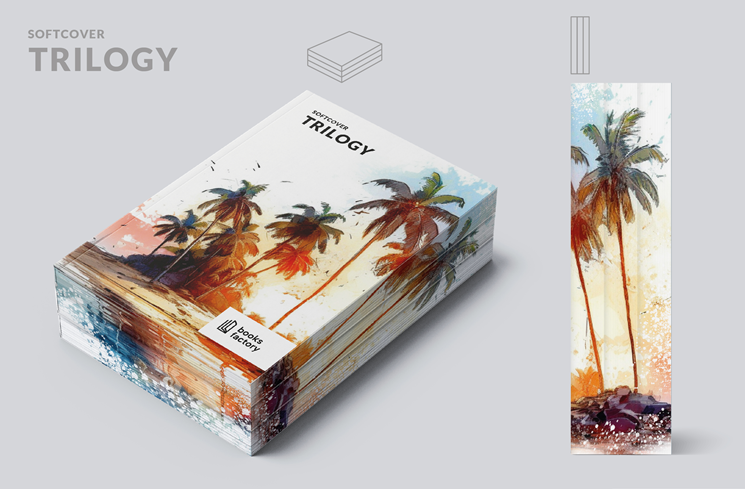
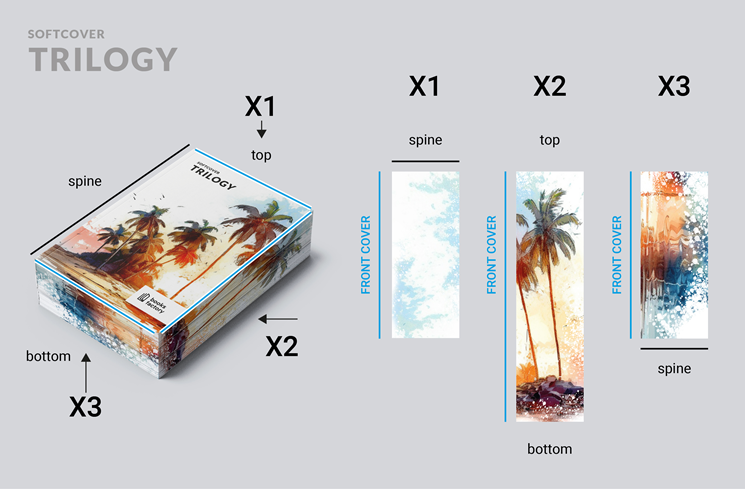
Risks and known problems:
- book edge printing does not cover the glueing,
- for technological reasons, minor ink drips may occur into the book block,
- a small quantity of the print run may be trimmed by 0.7 mm on the edges of the book block,
- printing in a solid colour is not recommended.
Die-cut window in the coverA die-cut window in a softcover is a hole made through all its layers. It can be located on the front, back, or on both sides of the book. In a softcover, it reveals either the first or last page. It is typically cut at a 90-degree angle (standard) relative to the cover. There are virtually no limitations on the shapes of die-cut windows. You need to prepare a mask similar to a UV varnish mask. In the mask, indicate the windows' appearance, number, and locations.
File preparation:
- the mask file should be prepared as a .pdf. The recommended standard is PDF/X-4:2010,
- the cut-out shape must be a vector – preferably a fill, not an outline,
- you should submit a PDF file containing three pages: the print cover, the print cover with the shape to be cut out
(position preview), and the cut-out mask (without cover):
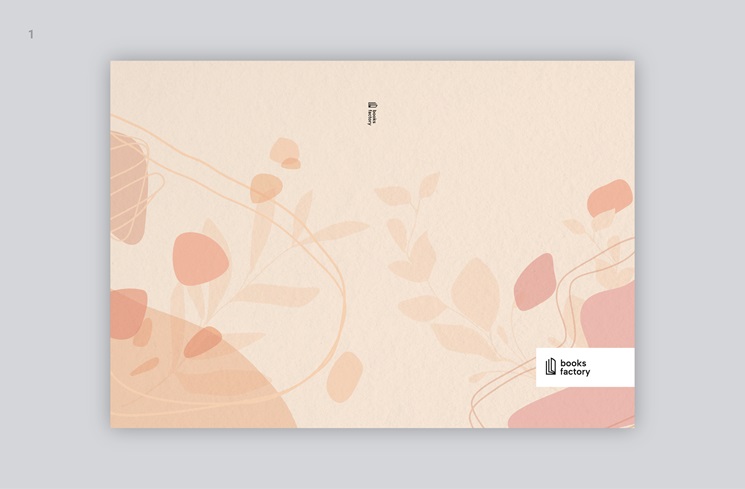
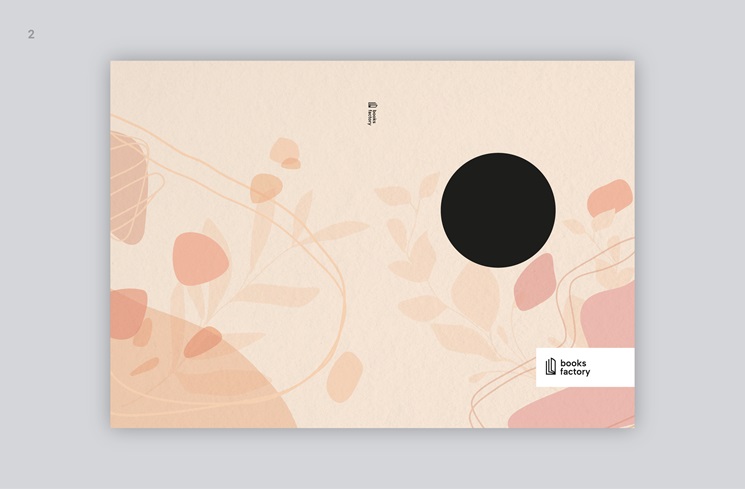
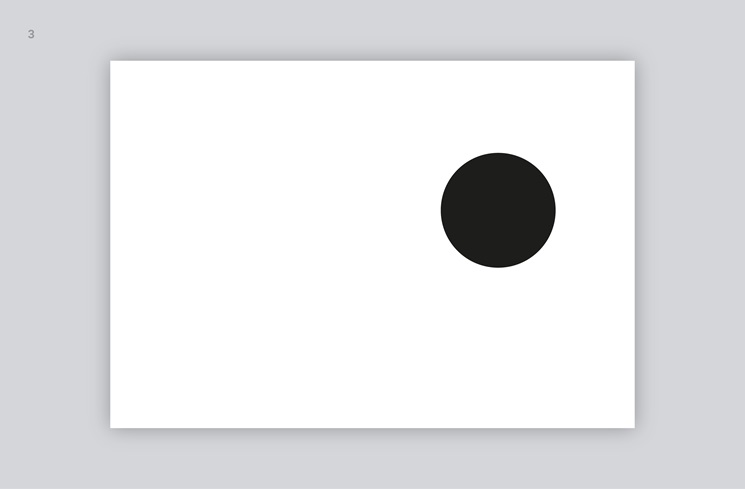
Technical notes:
- the safe cutting margins are 10 mm from the spine and 10 mm from the bottom edges:
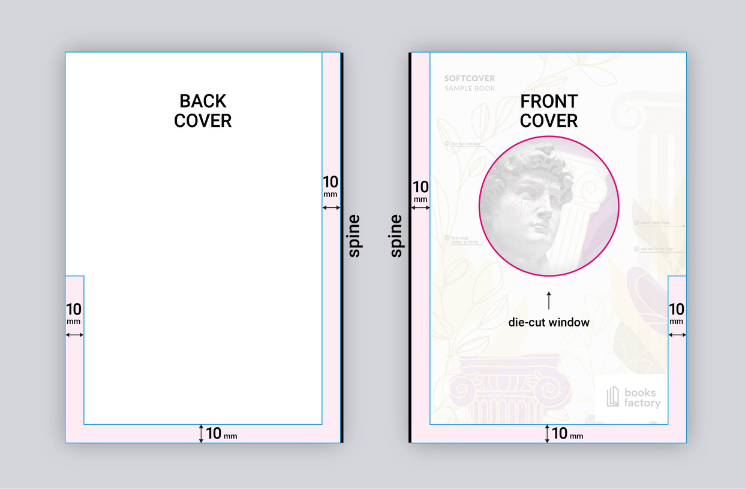
- it's possible to interrupt the edges of the cover. However, any openings must not extend into the lower half of the cover's outline,
and must maintain a minimum safety margin of 10 mm:
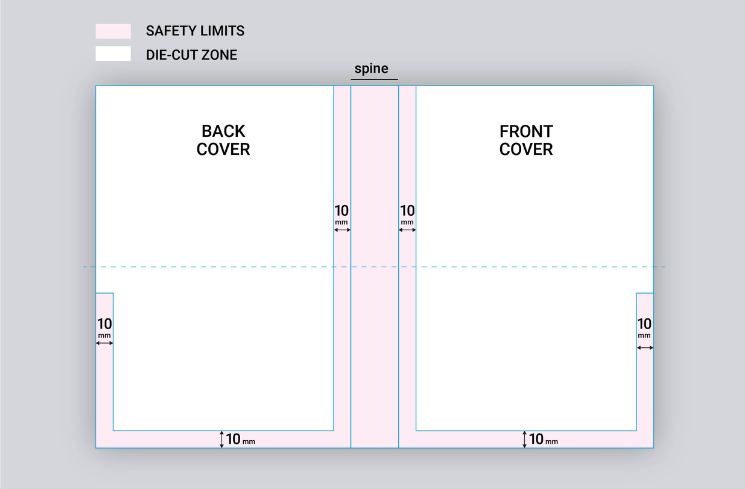
- cutting is possible for books with a maximum thickness of 50 mm,
- remember to design the first or last page of the block, which will become visible after the window in the cover is cut,
- the tolerance for the misalignment of objects between the cover and endpapers is up to 2 mm,
- we do not recommend, for example, inserting lines in the design which are to be continued on the part visible in the window.
Technical limitations for standard cuts in softcover (90 deg.):
- None. The DTP department can contact the client in case of highly complex projects.
We would be happy to give an opinion on the shape of your die-cut window if its specification goes beyond the above technical requirements.
|